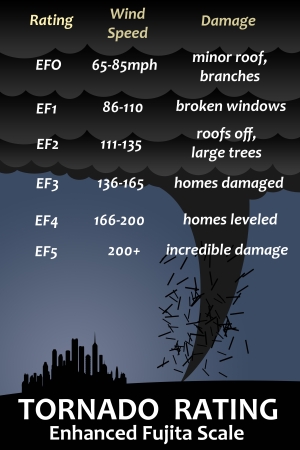Preparedness
Tornado
Click here to see "How a Tornado Works"
| FUJITA SCALE | DERIVED EF SCALE | OPERATIONAL EF SCALE | ||||
| F Number | Fastest 1/4-mile (mph) | 3 Second Gust (mph) | EF Number | 3 Second Gust (mph) | EF Number | 3 Second Gust (mph) |
| 0 | 40-72 | 45-78 | 0 | 65-85 | 0 | 65-85 |
| 1 | 73-112 | 79-117 | 1 | 86-109 | 1 | 86-110 |
| 2 | 113-157 | 118-161 | 2 | 110-137 | 2 | 111-135 |
| 3 | 158-207 | 162-209 | 3 | 138-167 | 3 | 136-165 |
| 4 | 208-260 | 210-261 | 4 | 168-199 | 4 | 166-200 |
| 5 | 261-318 | 262-317 | 5 | 200-234 | 5 | Over 200 |
Important Note About Enhanced Fujita Scale Winds
The Enhanced Fujita Scale, or EF Scale, is the scale for rating the strength of tornadoes in the United States estimated via the damage they cause.
Implemented in place of the Fujita scale, it began operational use on February 1, 2007. The scale has the same basic design as the original Fujita scale, six categories from zero to five representing increasing degrees of damage.
It was revised to reflect better examinations of tornado damage surveys, so as to align wind speeds more closely with associated storm damage. Better standardizing and elucidating what was previously subjective and ambiguous, it also adds more types of structures as well as vegetation, expands degrees of damage, and better accounts for variables such as differences in construction quality.
Tornado Watch
A tornado watch is issued when conditions are favorable for a tornado to occur. Remain alert for approaching storms.This is time to remind family members where the safest places within your home are located, and listen to the radio or television for further developments.Be prepared to seek shelter.
Tornado Warning
A tornado warning is issued when a tornado has been sighted in the area. Immediately seek safe shelter.
Prior to the Threat
Before you are faced with the threat of a tornado, plan now and be prepared.
- Conduct tornado drills each tornado season.
- Designate an area in the home as a shelter.
- Conduct tornado drills with your family.
- Know the difference between a "watch" and a "warning."
- Have Emergency Supplies on hand.
- Flashlight and extra batteries
- Portable, battery-operated radio and extra batteries
- First aid kit and manual
- Emergency food and water
- Non-electric can opener
- Essential medicines
- Cash and credit cards
- Sturdy shoes
If You See a Tornado
A tornado is one of nature's most awe inspiring events. Be familiar with this information if in the event you spot a tornado.
- Take cover immediately.Stay away from windows, doors, outside walls and open spaces.
- Protect your head from falling objects or flying debris.
- In public buildings, go to the pre-designated shelter areas.
- In a vehicle, trailer, or mobile home, get out immediately and go to a more substantial structure.
- Never get underneath a mobile home/trailer.
- Seek shelter on foot if possible.
- If there is no shelter nearby lie flat in the nearest ditch with your hands shielding your head.
During a Tornado
If you are in an area when a tornado strikes the following information is provided to help in protecting your family.
If in a Building:
- Go to the basement, storm cellar, or the lowest level of the building.
- If no basement, go to an inner hallway or a smaller inner room without windows.
- Get away from the windows.
- Get under a piece of sturdy furniture.
- Use arms to protect head and neck.
- If in a mobile home, get out and find shelter elsewhere.
If Outside:
- If possible, get inside a building.
- If shelter is not available, lie in a ditch or crouch near a strong building.
- Be aware of the potential for flooding.
- Use arms to protect head and neck.
If in a Car:
- Never try to out drive a tornado. Get out of the car and take shelter in a nearby building.
- If shelter is not available, lie in a ditch or crouch near a strong building.
- Be aware of the potential for flooding.
- Use arms to protect head and neck.
